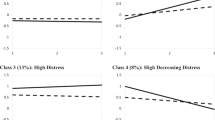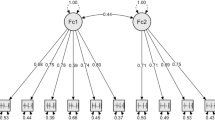Abstract
The purpose of the present study was to determine the prevalence and self-reported developmental antecedents of beliefs in storm and stress notions about adolescence, and to investigate the effects on such beliefs of an undergraduate course on adolescent development. Subjects were 192 college students who were enrolled in a course entitled “Psychology of Adolescence” at a large urban university. The questionnaire, which was administered at the beginning and end of the course, contained a storm and stress scale, items tapping the nature of parent-adolescent arguments, Dusek and Flaherty's (1981) Self-Concept Scale, and several demographic questions. Results suggested that beliefs in storm and stress notions are quite prevalent, arguments between parents and adolescents are believed to occur quite frequently, and females endorse storm and stress beliefs more readily than do males. Moreover, subjects tended to endorse storm and stress notions more readily if they viewed themselves as being less adjusted during their own adolescence and if they reported more adjustment instability. After a course on adolescent development, the tendency to report that the typical adolescent experiences storm and stress decreased, and this decrease was more pronounced for those receiving higher grades in the course.
Similar content being viewed by others
References
Adelson, J. (1979, February). Adolescence and the generation gap.Psychol. Today 33–37.
Anthony, J. (1969). The reactions of adults to adolescents and their behavior. In Caplan, G., and Lebovici, S. (eds.),Adolescence: Psychosocial Perspectives. Basic, New York.
Baldwin, B. A. (1986, October). Puberty and parents: Understanding your early adolescent.PACE: Piedmont Airlines 13–19.
Bandura, A. (1964). The stormy decade: Fact or fiction?Psychol. Schools 1: 224–231.
Beck, A. L., Adler, N. E., and Irwin, C. E. (1985). A comparison of nurses' attitudes toward hospitalized adolescents and adults.J. Adoles. Health Care 6: 211–215.
Bengston, V. L., and Cutler, N. E. (1976). Generations and intergenerational relations: Perspectives on age groups and social change. In Binstock, R. H., and Shanas, E. (eds.),Handbook of Aging and the Social Sciences. Van Nostrand Reinhold, New York.
Bengston, V. L., and Kuypers, J. (1971). Generational differences and the developmental stake.Aging Human Develop. 2: 249–260.
Blos, P. (1962).On Adolescence. Free Press, New York.
Blos, P. (1979).The Adolescent Passage. International Universities Press, New York.
Boxer, A. M., Solomon, B., Offer, D., Petersen, A. C., and Halprin, F. (1984). Parents' perception of young adolescents. In Cohen, R. S., Cohler, B. J., and Weissman, S. H. (eds.),Parenthood: A Psychoanalytic Perspective. Guilford Press, New York.
Conger, J. J., and Petersen, A. C. (1984).Adolescence and Youth: Psychological Development in a Changing World. Harper & Row, New York.
Cooper, C. R., Grotevant, H. D., and Condon, S. M. (1983). Individuality and connectedness in the family as a context for adolescent identity formation and role-taking skill. In Grotevant, H. D., and Cooper, C. R. (eds.),Adolescent Development in the Family. Jossey-Bass, San Francisco.
Czikszentmihalyi, M., and Larson, R. (1984).Being Adolescent: Conflict and Growth in the Teenage Years. Basic Books, New York.
Douvan, E., and Adelson, J. (1966).The Adolescent Experience. Wiley, New York.
Dusek, J., and Flaherty, J. (1981). The development of self-concept during the adolescent years.Monogr. Soc. Res. Child. Develop. 46 (Serial No. 191).
Erikson, E. (1968).Identity: Youth and Crisis. Norton, New York.
Frankel, S., & Dullaert, J. (1977). Is adolescent rebellion universal?Adolescence 12: 227–236.
Freud, A. (1958). Adolescence.Psychoanal. Stud. Child 13: 231–258.
Gelman, D. (1986, January 20). Treating teens in trouble: Can the psychiatric ward fill in for the family?Newsweek, pp. 52–54.
Grinker, R. R., and Werble, B. (1974). Mentally healthy young men (homoclites): Fourteen years later.Arch. Gen. Psychiatr. 30: 701–704.
Hall, G. S. (1904).Adolescence: Its Psychology and Its Relations to Physiology, Anthropology, Sociology, Sex, Crime, Religion, and Education. Prentice-Hall, Englewood Cliffs, NJ.
Hess, R. D., and Goodblatt, I. (1957). The status of adolescents in American society: A problem in social identity.Child Develop. 28: 459–468.
Hill, J. P. (1973). Some perspectives on adolescence in American society. Paper presented for the Office of Child Development of the United States Department of Health, Education, & Welfare.
Hill, J. P. (1980a). The family. In Johnson, M. (ed.),Toward Adolescence: The Middle School Years. The Seventy-ninth Yearbook of the National Society for the Study of Edducation. University of Chicago Press, Chicago.
Hill, J. P. (1980b).Understanding Early Adolescence: A Framework. Center for Early Adolescence, Chapel Hill, NC.
Hill, J. P., and Holmbeck, G. N. (1986). Attachment and autonomy during adolescence. In Whitehurst, G. J. (ed.),Annals of Child Development (Vol. 3). JAI Press, Greenwich, CN.
Hill, J. P., and Holmbeck, G. N. (1987). Familial adaptation to biological change during adolescence. In Lerner, R. M., and Foch, T. T. (eds.),Biological-Psychosocial Interactions in Early Adolescence, Erlbaum, Hillsdale, NJ.
Kandel, D., and Lesser, G. S. (1972).Youth in Two Worlds. Jossey-Bass, San Francisco.
Kazdin, A. E. (1980).Research Design in Clinical Psychology. Harper & Row, New York.
Lavigne, J. V. (1977). The pediatric hospital staff's knowledge of normal adolescent development.J. Pediatr. Psychol. 2: 98–100.
Lerner, R. M., Schroeder, C., Rewitzer, M., and Weinstock, A. (1972). Attitudes of high school students and their parents toward contemporary issues.Psychol. Rep. 31: 255–258.
Masterson, J. F. (1968). The psychiatric significance of adolescent turmoil.Am. J. Psychiatr. 124: 1549–1554.
Miller, C. L., Eccles, J. S., Flanagan, C., Midgley, C., Feldlaufer, H., and Goldsmith, R. (1987). What parents and teachers believe about adolescence. Unpublished manuscript, University of Michigan, Ann Arbor.
Montemayor, R. (1982). The relationship between parent-adolescent conflict and the amount of time adolescents spend alone and with parents and peers.Child Develop 53: 1512–1519.
Montemayor, R. (1983). Parents and adolescents in conflict: All families some of the time and some families most of the time.J. Early Adoles. 3: 83–103.
Montemayor, R. (1986). Family variation in parent-adolescent storm and stress.J. Adoles. Res. 1: 15–31.
Montemayor, R., & Hanson, E. (1985). A naturalistic view of conflict between adolescents and their parents and siblings.J. Early Adoles. 5: 23–30.
Musgrove, F. (1963). Intergenerational attitudes.Brit. J. Soc. Clin. Psychol. 2: 209–223.
Offer, D., and Offer, J. B. (1975).From Teenage to Young Manhood: A Psychological Study. Basic Books, New York.
Offer, D., Ostrov, E., and Howard, K. I. (1981a).The Adolescent: A Psychological Self-Portrait. Basic Books, New York.
Offer, D., Ostrov, E., and Howard, K. I. (1981b). The mental health professional's concept of the normal adolescent.AMA Arch. Gen. Psychiatr. 38: 149–153.
Offer, D., Sabshin, M., and Marcus, D. (1965). Clinical evaluation of normal adolescents.Am. J. Psychiat. 121: 864–872.
Oldham, D. G. (1978). Adolescent turmoil: A myth revisited. In Feinstein, S. C., and Giovacchini, P. L. (eds.),Adolescent Psychiatry: Developmental and Clinical Studies (Vol. 6). University of Chicago Press, Chicago.
Paris, S. G., and Landauer, B. K. (1977). Constructive aspects of children's comprehension and memory. In Kail, R. V., and Hagan, J. W. (eds.),Perspectives on the Development of Memory and Cognition. Erlbaum, Hillsdale, NJ.
Reese, H. W. (1976). The development of memory: Life-span perspectives. In Reese, H. W. (ed.),Advances in Child Development and Behavior (Vol. 11). Academic, New York.
Riegel, K. F. (1977). The dialectics of time. In Datan, N., & Reese, H. W. (eds.),Life-span Developmental Psychology: Dialectic Perspectives on Experimental Research. Academic, New York.
Roll, E. J. (1980). Psychologists' conflicts about the inevitability of conflict during adolescence: An attempt at reconciliation.Adolescence 15: 661–670.
Rutter, M., Graham, P., Chadwick, O., and Yule, W. (1976). Adolescent turmoil: Fact or fiction?J. Child Psychol. Psychiatr. 17: 35–56.
Simmons, R. G., and Rosenberg, F. (1975). Sex, sex roles, and self-image.J. Youth Adoles. 4: 229–258.
Steinberg, L. (1985).Adolescence. Knopf, New York.
Stone, L. J., and Church, J. (1968).Childhood and Adolescence: A Psychology of the Growing Person (2nd ed.). Random, New York.
Weiner, I. B. (1970).Psychological Disturbance in Adolescence. Wiley, New York.
Weiner, I. B. (1971). The generation gap-Fact and fancy.Adolescence 6: 155–166.
Westley, W. (1958). Emotionally healthy adolescents and their family backgrounds. In Goldstein, I. (ed.),The Family in Contemporary Society. International Universities Press, New York.
Author information
Authors and Affiliations
Additional information
Received his Ph.D. in Clinical Psychology from Virginia Commonwealth University. Interests are family relations during adolescence, pediatric psychology, child clinical psychology, and statistical applications in psychology.
Received his Ph.D. in Clinical Psychology from Harvard University. Interests are the social psychology of adolescence and psychosocial adaptation to biological change.
Rights and permissions
About this article
Cite this article
Holmbeck, G.N., Hill, J.P. Storm and stress beliefs about adolescence: Prevalence, self-reported antecedents, and effects of an undergraduate course. J Youth Adolescence 17, 285–306 (1988). https://doi.org/10.1007/BF01537671
Received:
Accepted:
Issue Date:
DOI: https://doi.org/10.1007/BF01537671




